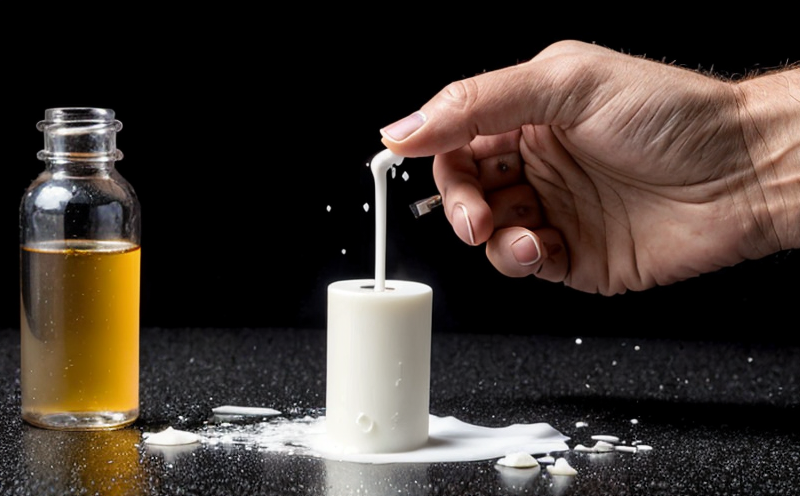USP Inhalation Suspension Dissolution Testing
The USP Inhalation Suspension Dissolution Test is a critical procedure used in pharmaceutical development to ensure that inhalation suspensions are properly formulated and manufactured. This test evaluates the dissolution of active pharmaceutical ingredients (APIs) from an aerosol suspension, ensuring they meet the necessary release profile standards as defined by the United States Pharmacopeia (USP). The primary objective of this test is to assess the extent to which the drug substance in a suspension form dissolves and becomes available for inhalation therapy.
The process involves simulating the conditions of aerosol delivery, where the sample is subjected to agitation similar to that experienced during inhalation. This helps to determine if the product can deliver its intended dose uniformly across all particles. The test is particularly important in ensuring that the formulation meets both efficacy and safety standards, especially for products targeting lung diseases such as asthma or chronic obstructive pulmonary disease (COPD).
The USP dissolution test apparatus consists of a suitable agitation system and a sampling device capable of collecting samples at specified intervals. The suspension is prepared according to the manufacturer's instructions and then placed into the dissolution vessel, which is agitated under controlled conditions that mimic inhalation delivery.
| Parameter | Description |
|---|---|
| Air flow rate | The air flow through the agitation system should be set to simulate human breathing patterns during inhalation, typically ranging from 60 to 120 L/min. |
| Temperature | The temperature of the dissolution medium is crucial and must be held at a constant level to ensure accurate results. It is usually set between 37°C ± 0.5°C. |
| Sampling intervals | Dissolution samples are collected at predetermined time points, which can vary depending on the product's characteristics but often include initial and final sampling after a specified period of agitation. |
The results of this test provide important insights into the performance of inhalation suspensions. If the dissolution profile does not meet the prescribed standards, it may indicate issues with particle size distribution or formulation stability. Such discrepancies could lead to inconsistent drug delivery and potentially affect patient outcomes.
- Ensures consistent API release
- Maintains product efficacy
- Meets regulatory requirements for inhalation products
- Aids in process optimization during development
- Enhances quality control processes
In summary, the USP Inhalation Suspension Dissolution Test is a vital step in ensuring that inhalation suspensions are properly formulated and deliver their intended therapeutic effect. By following this rigorous procedure, pharmaceutical manufacturers can ensure product consistency and reliability, thereby enhancing patient safety and satisfaction.
Benefits
The USP Inhalation Suspension Dissolution Test offers several key benefits to the development and manufacturing of inhalation products:
- Ensures regulatory compliance: By adhering to USP standards, manufacturers can ensure that their products meet stringent quality control requirements.
- Improves product consistency: This test helps in identifying issues related to particle size and formulation stability, leading to more consistent drug delivery.
- Promotes patient safety: Ensuring the correct dissolution of APIs is critical for maintaining the efficacy and safety of inhalation products.
- Facilitates process optimization: The insights gained from this test can be used to refine manufacturing processes, leading to more efficient production methods.
- Enhances quality control: Regular testing helps in maintaining high standards throughout the product lifecycle.
- Supports R&D efforts: By providing detailed dissolution data, this test aids researchers in developing better formulations and improving product performance.
In conclusion, the USP Inhalation Suspension Dissolution Test is an indispensable tool for ensuring the quality and reliability of inhalation suspensions. It plays a crucial role in meeting regulatory standards, enhancing patient safety, and supporting continuous improvement in manufacturing processes.
Why Choose This Test
Selecting the USP Inhalation Suspension Dissolution Test for your product development or quality assurance strategy offers several compelling reasons. Here are some key points to consider:
- Regulatory compliance: Ensures that your product meets the stringent requirements set by the United States Pharmacopeia.
- Consistency and reliability: Provides reliable data on API dissolution, ensuring consistent product performance across batches.
- Patient safety: Helps in identifying potential risks related to drug delivery, thereby enhancing patient safety.
- Process optimization: Offers insights into the formulation and manufacturing processes, aiding in continuous improvement.
- Quality assurance: Facilitates robust quality control measures, ensuring product consistency and reliability.
- Research support: Provides valuable data for R&D efforts, supporting innovation and development of better products.
The USP Inhalation Suspension Dissolution Test is a cornerstone in the pharmaceutical industry, offering comprehensive testing to ensure high-quality inhalation suspensions. By choosing this test, you are investing in product quality and patient safety.
Use Cases and Application Examples
The USP Inhalation Suspension Dissolution Test is widely used in the pharmaceutical sector for various applications:
| Use Case | Description |
|---|---|
| New drug development | Determines API dissolution during early stages of product formulation. |
| Batch release testing | Evaluates the quality and consistency of each batch produced. |
| Process validation | Confirms that the manufacturing process consistently produces products meeting specified standards. |
| Diagnostics | Identifies potential issues in formulation or processing leading to suboptimal dissolution profiles. |
| Quality assurance | Maintains high product quality through regular testing and monitoring of production processes. |
In addition, this test is often used during the lifecycle management of inhalation products. For instance, it can help in troubleshooting issues related to poor drug delivery or inconsistent performance across different batches. By conducting this test at various stages of product development and manufacturing, pharmaceutical companies can ensure that their inhalation suspensions meet both regulatory and customer expectations.





